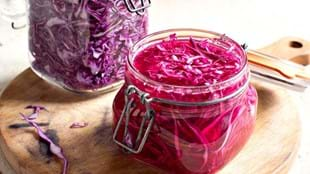Make time: 30 minutes
Fermenting time: 10 days – three weeks
Makes/Serves: two large jars
Equipment required: mandolin
This sauerkraut uses a combination of red cabbage and beetroot, you can omit the beetroot and just use more cabbage, but the beets make it a slightly sweeter, more versatile and delicious kraut that you can toss through salads and pile on top of your avo toasts. Not on is it tasty and adaptable, this fermented goodness offers many health benefits too.
Ingredients
1 Red Cabbage
1 large Beetroot
2 ½ tbsp Sea Salt
10 Juniper Berries
1 tsp Caraway Seeds
1 large jar or crock
A small piece of cotton or hemp fabric
Rubber band or string
Method
Clean the area and equipment (including your hands) thoroughly. You don't want any extra bacteria to make its way in and ruin your kraut making efforts.
Remove any of the limp outer leaves of the cabbage and discard. It's useful to reserve a few of the larger leaves for later but make sure they are fresh ones.
Shred the cabbage finely on a mandolin (or by hand) and place in a large mixing bowl. Then finely slice the beetroot into rounds using a mandolin, alternatively you could grate it if you prefer not to have the large pieces of beetroot. Place it in the bowl with the cabbage.
Sprinkle the salt over the mixture and massage thoroughly for around 2-3 mins, you want it to start softening, and you will see the color of the cabbage change. Then add in the juniper berries and caraway seeds. Let the mixture sit for one hour so the salt can draw the liquids out from the cabbage and beetroot and the mixture softens further.
Pack the mixture into an appropriate sized jar/container as tight as you can, using your fist to press it down. If you don't have a large jar you can use several smaller AEG type ones.
Note: Using a smaller jar may result in a quicker fermenting time, so make sure you check progress regularly if you're doing this.
Pour any remaining juice from the bowl into the jar over your soon to be sauerkraut. Place one of the larger outer leaves of the cabbage you reserved earlier (or some baking paper) on top of the mixture and press down to ensure the sauerkraut mixture is fully submerged in its liquid. Make sure there is no air hitting the cabbage at any point.
You can place a little weight on top of the cabbage leaf to ensure it keeps everything fully submerged-a small jar or glass could be used for that.
Place a thick piece of fabric over the jar and tie securely with a rubber band or some string.
Over the next 24 hours, press down on the sauerkraut every so often to further compact it. As the cabbage and beetroot releases its liquid, it will soften and you can compact it down further helping more liquid to rise over the top of the cabbage. You can now cover the jar with a lid or plate (we have used a weck jar with glass lid and a rubber seal that will allow any gas to release at a certain pressure).
Let the jar sit in a dark room with a temperature of around 18 degrees for 10 days – three weeks, until it is ready and has achieved a nice sour flavor. Remember a smaller batch will ferment quickly so check regularly to see if it's ready.
While it's fermenting you may see bubbles coming through the cabbage or foam on the top – sometimes even a white scum. Don't worry, these are all normal. The scum can be skimmed off the top before refrigerating.
If you see any mould, remove it immediately. Remember to make sure your cabbage is fully submerged (if it’s fully submerged then mould shouldn’t occur). Do not eat any sauerkraut that has been in contact with mouldy parts close to the surface, remove the mould and any surrounding sauerkraut and check the remaining kraut to see if it has been affected. This type of mould is not good moulds so please be vigilant with that.
Sauerkraut will keep in the fridge for a minimum of one to two months in a sealed jar – make sure it's not exposed to air to maintain freshness. As long as the kraut still tastes good it will be good to eat.
Courtesy of Little Bird Organics







